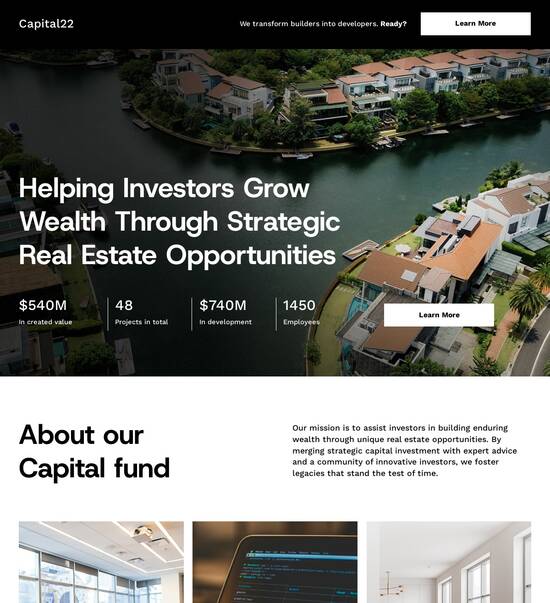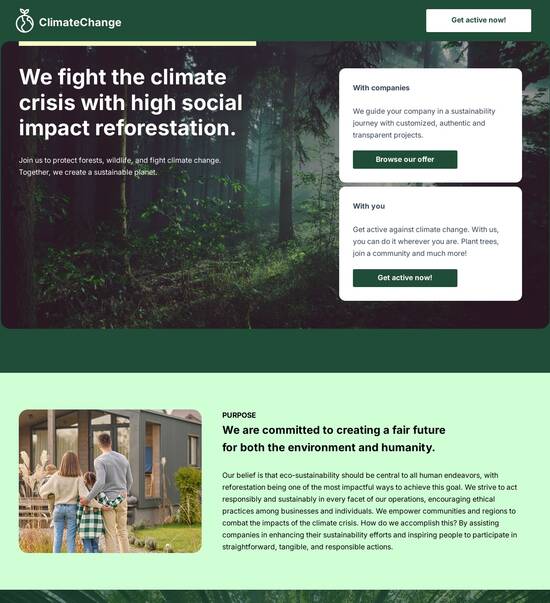
Elegant wishlist page template
Explore Similar TemplatesAbout template
Unleash your creativity with the elegant wishlist page template. Try Instapage today.
Recommended templates

Easy to build without coding
With the intuitive drag-and-drop builder, anyone on your team can create high-converting pages without any knowledge of code or design. Make enhancements to your landing page with custom widgets using Javascript, HTML/CSS, or third-party scripts.

Multiple layouts for any industry and goal
Select from 500+ landing page layouts built to boost conversions across industry-specific scenarios. Customize them by adjusting fonts, adding images, and generating on-brand content with the AI assistant. Quickly scale with Instablocks® and Global Blocks that you can save, reuse, and update globally.

Loads fast and looks polished on any device
Every template is responsive, which means they present professionally on any device and load blazingly fast with our Thor Render Engine. You can also power them up with Google AMP technology to deliver an unparalleled mobile experience and drive higher conversions.

Robust analytics & experimentation
Get real-time updates and reporting across all your devices, showing the number of visitors, conversions, cost-per-visitor, and cost-per-lead. Launch AI-powered experiments, run A/B tests, and use heatmaps to analyze user behavior, then optimize your landing page to maximize conversions.







Easy to build without coding
With the intuitive drag-and-drop builder, anyone on your team can create high-converting pages without any knowledge of code or design. Make enhancements to your landing page with custom widgets using Javascript, HTML/CSS, or third-party scripts.
Multiple layouts for any industry and goal
Select from 500+ landing page layouts built to boost conversions across industry-specific scenarios. Customize them by adjusting fonts, adding images, and generating on-brand content with the AI assistant. Quickly scale with Instablocks® and Global Blocks that you can save, reuse, and update globally.
Loads fast and looks polished on any device
Every template is responsive, which means they present professionally on any device and load blazingly fast with our Thor Render Engine.
Robust analytics & experimentation
Get real-time updates and reporting across all your devices, showing the number of visitors, conversions, cost-per-visitor, and cost-per-lead. Launch AI-powered experiments, run A/B tests, and use heatmaps to analyze user behavior, then optimize your landing page to maximize conversions.
All the features you need to build wish list or wishlist
Explore more featuresLearn how to build wishlistpage
Frequently asked questions about sample of wish list
Leading the way in building high-performing landing pages





Wishlist page design: Your ultimate how-to guide
Creating high-converting landing pages is essential for marketers looking to maximize ROI through optimized campaigns. Instapage offers a powerful platform designed to help you quickly build landing pages that meet your specific marketing goals. In this guide, we will walk you through the steps of leveraging Instapage to create stunning landing pages while providing insights on best practices that can boost your conversion rates.
Understanding the basics of landing pages
Landing pages serve as specialized web pages focused on a specific offer or goal. Unlike your homepage, a landing page is designed to convert visitors through persuasive content and calls-to-action. Familiarizing yourself with how to structure these pages using Instapage is crucial. Here’s a quick breakdown of why using dedicated landing pages is beneficial:
- Focused messaging: Each landing page addresses a single objective, helping to eliminate mixed messaging.
- Enhanced user experience: Streamlined content guides visitors toward the desired action without distractions.
- Better analytics: Analyze conversion rates and user interactions specific to each campaign.
Step 1: Choosing a high-converting template
Instapage provides over 100 templates that cater to various industries and marketing goals. Selecting the right template is key to launching successful campaigns quickly. Here are some elements to consider when choosing a template:
- Industry relevance: Ensure the template aligns with your business vertical, whether it’s tech, education, or financial services.
- Design versatility: Choose a design that can showcase your branding while still being adaptable for various marketing campaigns.
- Conversion-focused elements: Look for templates that include proven CTA placements and engaging visual designs.
Step 2: Customizing your landing page content
Once you have chosen a template, it's time to personalize it. Use Instapage’s intuitive builder to modify text, images, and layout. Consider the following for effective customization:
- Dynamic text replacement: Tailor the landing page content based on the visitor's source for better relevance and engagement.
- AdMaps: Align your ads to unique landing pages to ensure consistency and reinforce messaging.
- High-quality visuals: Integrate eye-catching images or videos that resonate with your target audience.
Step 3: Optimizing for conversion
Optimization is vital to ensure your landing pages are performing effectively. Instapage includes tools to help you analyze and adjust based on real-time data. Focus on these optimization strategies:
- A/B testing: Utilize built-in experimentation features to test different elements of your landing page and determine what drives higher conversions.
- Heatmaps: Analyze user behavior on your page to understand which areas are capturing attention and which ones need improvement.
- Analytics dashboard: Regularly check performance metrics to assess the effectiveness of your landing pages.
By following these steps, you'll be well on your way to creating landing pages that not only look great but also drive measurable results for your campaigns.
Ready to elevate your digital marketing strategy? Start using Instapage today for a streamlined landing page creation process that maximizes your ROI!
People also ask about aesthetic wishlist template
Creating an elegant wishlist page template: A guide for marketers
Conceptual foundations of an elegant wishlist page template
At its core, a wishlist page serves as a personalized collection of items that a user wishes to purchase, making it an integral part of the shopping experience. It transforms vague aspirations into a tangible list, allowing users to track their desires and streamline their purchasing decisions. A well-designed wishlist appeals not only to the practicality of shopping but also to emotional facets, fostering a deeper connection with the brand.
A wishlist often includes essential elements such as product images, descriptions, pricing, and link options leading back to the products themselves. These features work in harmony to ensure that users do not merely save items but create a curated selection that captures their interests and aspirations.
Product images that entice users.
Detailed descriptions providing essential information.
Direct links for easy navigation to product pages.
Options for item prioritization or quantity adjustment.
The importance of personalization
Personalization is a powerful tool in transforming a standard wishlist into a dynamic shopping experience. By tailoring the items displayed to user preferences and behavior, marketers can create relevant offerings. Utilizing collected data can suggest items aligned with user habits. For instance, recommending accessories that complement a wishlisted item can significantly enhance engagement.
Moreover, recognizing and leveraging special occasions such as birthdays and anniversaries can make wishlists even more relevant. Brands that allow users to set reminders for these occasions can engage consumers, ensuring that the wishlist is not just a fleeting thought but a practical tool in their shopping arsenal.
User data analytics to curate suggestions.
Occasion-based prompts for wishlist management.
Emails about wishlist items on special dates.
Innovative features of the elegant wishlist page template
Aesthetic appeal is vital in crafting a wishlist page that delights users. The choice of color schemes, font styles, and layout can significantly influence how visitors interact with the content. Ideally, the design should foster a seamless user journey, guiding them intuitively through the wishlist without overwhelming them with information or clutter.
High-quality visuals also play a crucial role; images that highlight the details and beauty of products can propel a user’s desire to act. Utilizing a minimalist approach to design, where each element has a purpose, can create an attractive and effective wishlist page.
Use of visually appealing color palettes.
Typography that enhances readability and visual appeal.
Minimalist layouts that guide users effortlessly.
Integration of high-resolution images for product display.
Functional components that drive engagement
While aesthetics are important, functional elements are what will keep users engaged and coming back. Key features to include in a wishlist template involve providing essential product descriptions, links that lead to where the product can be purchased, and the ability to adjust quantities directly from the wishlist. Allowing users to rank items by priority or urgency is another beneficial aspect.
Additionally, incorporating sharing options for social media or email helps extend the reach of the wishlist. Users can share their lists with friends and family, creating collaborative shopping experiences and driving new traffic to the website.
Incorporate product descriptions directly in the wishlist.
Enable quantity adjustments for each wishlisted item.
Add priority ranking features for personalization.
Include sharing options through social media and email.
Dynamic wishlist capabilities
To enhance engagement, it’s crucial to ensure that the wishlist remains up-to-date in real time. When users interact by adding or removing items, these changes should reflect instantly. Implementing features that allow wishlists to evolve as user preferences change can empower users to manage their desires actively.
Integrating the wishlist with existing shopping platforms can further streamline the purchasing process. By linking a wishlist to a user’s shopping cart, you provide a seamless path from wishlisting to buying, making it easier for the consumer to realize their wishes.
Real-time synchronization of added or removed items.
Options for users to categorize and modify their lists.
Direct integration with shopping platforms for easy checkout.
Harnessing the power of customer insights
Understanding user desires and preferences can drive the success of a wishlist page. By collecting data on what users frequently add to their wishlists, brands can identify trends and adjust their offerings accordingly. Analyzing this data is crucial for maintaining relevancy and ensuring that wishes align with what’s actually popular on the market.
In addition to understanding data patterns, it’s essential to actively engage with users. Methods such as surveys and feedback forms can provide insights into their wishlist experiences, leading to improvements or new feature implementations based on user suggestions.
Utilize analytics to track wishlist trends and patterns.
Engage users through surveys for feedback.
Iterate offerings based on real user input.
Transforming wishlists into strategic sales tools
Marketers can leverage the power of wishlists as strategic sales tools to target their advertising effectively. By tracking common items added to wishlists, businesses can create tailored marketing strategies that resonate with potential customers. For instance, if a particular item sees a spike in wishlist additions, specialized promotions could be targeted toward those products.
Additionally, incorporating seasonal elements into wishlist strategy can further enhance effectiveness. Brands can promote special occasion gift ideas that align perfectly with customers’ interests, ensuring the wishlist acts not just as a storage space but as a holiday shopping guide.
Analyze wishlist data to create targeted marketing strategies.
Develop promotions based on high-demand wishlist items.
Curate special occasion gift lists for users.
Enhancing user experience through reality and intuitive tools
A user-friendly wishlist is essential for ensuring a positive shopping journey. Features like advanced filtering options and search functionalities allow users to quickly locate desired items without navigating through unrelated products. Autocomplete functionalities can enhance this experience further by suggesting items as users type, reducing friction in the wishlist process.
Furthermore, adding extras such as gift wrapping options or personalized messages can turn the wishlist into a complete gifting solution. Reward programs linked to wishlist usage encourage customers to engage more frequently, enhancing loyalty and increasing conversion rates.
Implement sorting and filtering tools to simplify searches.
Integrate autocomplete functionalities for ease of use.
Include options for gift wrapping and personalization.
Connect loyalty programs to wishlist interactions.
Case studies and real-world applications
Numerous brands have effectively implemented elegant wishlist page templates, showcasing their ability to draw users in and improve conversion rates. E-commerce giants such as Amazon provide personalized recommendations based on user behavior, emphasizing the role of the wishlist in guiding purchase decisions. However, effective use isn’t limited to large corporations. Many local businesses have adopted whimsical wishlist ideas that reflect their unique branding and increase customer engagement.
User testimonials illustrate the transformative nature of these templates. Individuals frequently express how wishlist features help them keep track of their desired products, especially during holiday seasons, while brands report increased customer retention and higher conversion rates.
Analysis of brands effectively using wishlist templates.
Insights on successful campaigns from e-commerce giants.
Spotlight on local businesses and their unique implementations.
Future trends in wishlist page design
The future of wishlist pages is poised for innovation with the integration of emerging technologies. Augmented reality might soon play a role in how users visualize products in their environments before adding them to their wishlist, building confidence in the purchasing process. Additionally, the use of artificial intelligence can assist in curating personalized wishlists, suggesting new items based on past behaviors and preferences.
Sustainability considerations are also becoming increasingly important. Wishlist features that highlight eco-friendly products or promote ethical choices reflect a growing consumer consciousness towards responsible shopping. This trend is likely to shape how brands position their products and engage customers through their wishlists.
Integration of augmented reality in product visualization.
AI-driven features for personalized wishlist suggestions.
Focus on sustainability and ethical consumption in offerings.
Conclusion of key insights
Creating an elegant wishlist page template is not simply about aesthetics; it requires a deep understanding of users’ needs and desires. Through well-executed personalization and innovative features, wishlist templates can greatly enhance the user experience, ultimately leading to increased loyalty and sales. As technology continues to evolve, the potential for incorporating new elements into wishlist experiences presents exciting opportunities for marketers.
By effectively aligning aspirations with actionable shopping paths, elegant wishlist templates not only facilitate purchasing but also contribute meaningfully to user experience in a competitive marketplace.
Ready to skyrocket conversions?
Supercharge your ad campaigns with high-performing landing pages
Get started














